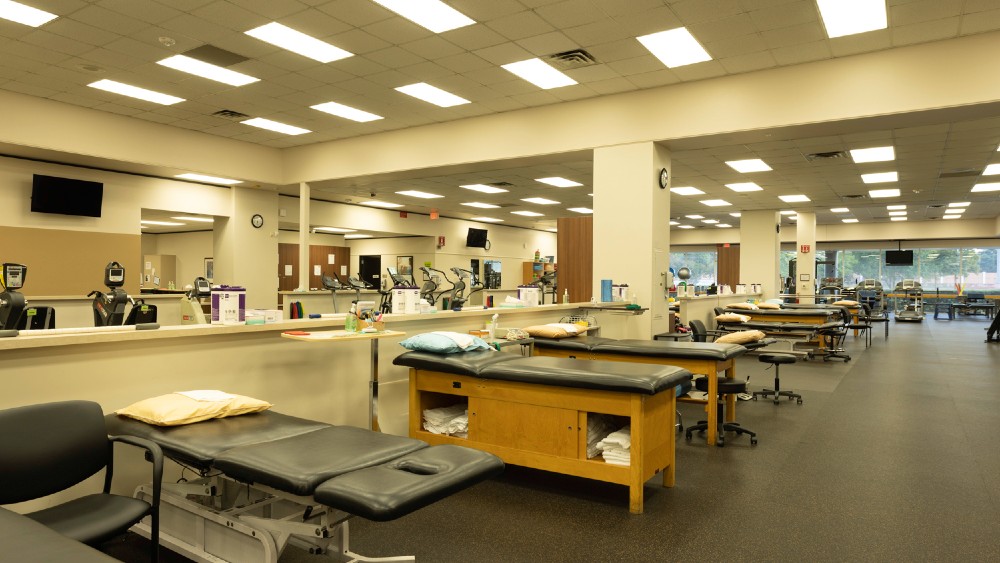Physical Therapy Solutions for Pelvic Floor Health
You may be surprised to know that one in five people will suffer from a pelvic floor disorder at some time during their lifetime. Pelvic floor disorders (PFD) can affect both men and women, and may cause pain or discomfort that interferes with quality of life and the ability to enjoy everyday activities.
At Memorial Hermann, we take a comprehensive approach to identifying the source of each patient’s disorder in order to develop personalized treatment plans. You can seek physical therapy for pelvic floor conditions without a referral at our Sports Medicine & Rehabilitation locations or, if you need more advanced treatment, you can join the Memorial Hermann Pelvic Floor Program.
What is the pelvic floor?
The pelvic floor is a group of muscles, connective tissue and ligaments that supports your pelvic organs and controls the flow of urine and bowel movements. The muscles are arranged like a sling to provide support for the bladder and rectum, as well as the vaginal cavity and uterus for women, and the prostate for men.
What are pelvic floor disorders (PFD)?
When the pelvic floor is weakened or damaged, your pelvic organs may not function properly. With PFD, you may be unable to control the muscles in your pelvic floor which can affect your bladder and bowel habits. PFD may also cause pain and can interfere with sexual function.
Good pelvic health is important in order to maintain bladder, bowel and sexual function. It is also an important part of being able to get out and enjoy the things you like to do, without pain, discomfort or embarrassment.
Pelvic floor disorders are not a normal part of aging. While it is more common to experience PFD as you get older, these are never considered “normal,” and should be evaluated by a health care provider.
Physical therapy is a great place to start
If you have pain or discomfort, or are avoiding the things you normally enjoy, take the first step towards recovery. Pelvic floor physical therapy is a non-invasive way to improve your symptoms and help restore your quality of life.
What is pelvic floor physical therapy?
As part of our comprehensive approach to the diagnosis and care of pelvic floor disorders (PFD), we offer pelvic floor physical therapy as a non-surgical treatment option to help address pain, weakness, or dysfunction in the pelvic floor muscles.
Memorial Hermann pelvic floor physical therapists are especially trained to individually evaluate and treat the pelvic floor and related symptoms. Our therapists aim to restore your pelvic health, and provide treatment for common conditions such as:
- Pelvic pain
- Urinary Incontinence
- Fecal incontinence
- Mixed incontinence
- Gender confirmation
- Gynelogical Cancer
- Constipation
- Coccydynia
- Painful intercourse
- Pelvic organ prolapse
- Pediatric conditions such as constipation, nocturia and vesicoureteral reflux
- Prostactectomy
- Post-partum care
- Diastasis Rectus Abdominis (DRA)
No referral is required to schedule an initial evaluation. Your physical therapist will determine if you are a candidate for pelvic floor physical therapy, and will provide a plan of care designed to meet your goals.
Find a Location Find a Physical Therapist About Pelvic Floor Health Centers
If further treatment is required, the providers at the Memorial Hermann Pelvic Floor Program can connect you to a team of affiliated specialists uniquely qualified to address issues of the pelvic floor.
What is the Memorial Hermann Pelvic Floor Program?
Patients seeking care from the Pelvic Floor Program will experience a network of providers who work together to customize a plan of care. Memorial Hermann’s Pelvic Floor Health Centers offer a multidisciplinary, evidence-based approach to help diagnose and treat PFD. Because these disorders can result from various factors and conditions, our specialists utilize state-of-the-art imaging and diagnostic technology to help pinpoint the causes of dysfunction.
Some treatment plans may combine therapies when appropriate to achieve the best possible outcome. Each patient’s case is reviewed thoroughly by our entire panel of affiliated specialists, including:
- Urogynecologists (Female Pelvic Medicine and Reconstructive Surgery)
- OB/GYNs
- Colon Rectal Surgeons
- Gastroenterologists
- Urologists
- Pelvic Floor Physical Therapists
- Neurologists
- PM&R
Learn More About Pelvic Floor Health Centers
In many cases, physical therapy can be a first step for the treatment of pelvic floor conditions.
What to expect: Initial Evaluation for Pelvic Floor Physical Therapy
During the first appointment, your physical therapist will conduct a comprehensive evaluation. The goal of this evaluation is to determine the source of your problem, and also to determine which therapy practice(s) will be most effective for you.
The assessment may include an evaluation of both external and internal pelvic floor muscles. This means that a pelvic examination may be performed to better asses your pelvic floor. You may be asked to stand, walk and sit so the therapist can see whether you have posture or joint issues that could be affecting the pelvic floor muscles.
Based on your specific condition and health goals, your physical therapist will develop a treatment plan to get you on the road to recovery. If physical therapy is not appropriate for your condition, or if additional care is needed, your therapist will guide you to the appropriate provider.
What causes pelvic floor disorders?
While pelvic floor conditions can affect both men and women, multiple life events may cause pelvic floor disorders. For women, life events like pregnancy and childbirth are common causes that lead to disorders and may continue in menopause. The following experiences or conditions may damage or weaken your pelvic floor:
- Giving birth (vaginal or c-section)
- Obesity
- Chronic constipation or loss of bladder control
- Genetics
- Pelvic floor nerve or tissue damage from surgery or radiation
- History of lifting or moving heavy objects
- Slip/fall onto tailbone
- Cycling
- Long distance running
Techniques and Treatments Offered
Depending on your condition, your therapist may recommend internal or external physical therapy techniques, or a combination of both. For many people, the goal of pelvic floor physical therapy is to strengthen muscles. Other people may benefit from therapy that assists with lengthening and relaxing muscles.
External physical therapy techniques may include:
- Nerve release
- Trigger point therapy
- Myofascial release, also called deep tissue massage
- Skin rolling
- Joint mobilization
- Visceral manipulation
- Muscular cueing
- Dry needling
- Instrument soft tissue technique
Internal techniques may include:
- Trigger point therapy - Using a specialized instrument or manually putting pressure on a specific spot
- Kegel exercises to strengthen your muscles
- Muscle energy techniques
- Manual activation and muscular cueing
- Dry needling
If appropriate for your condition, pelvic floor physical therapists also use tools and technology to help treat pelvic floor dysfunction.
Ready for Relief?
If you’re interested in finding relief through physical or occupational therapy, the therapists at Memorial Hermann Sports Medicine & Rehabilitation are here to help. Request an initial evaluation appointment by filling out the form below or calling (713) 521-0020 or (888) 301-8477.


















